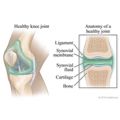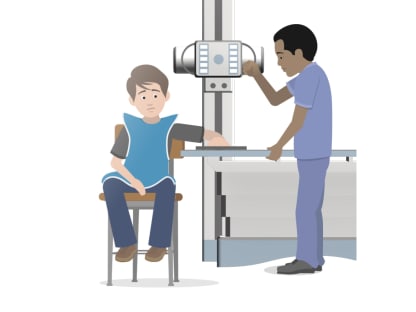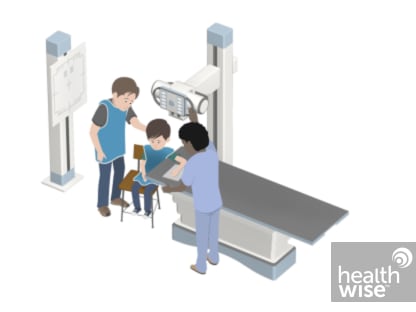Arthrogram (Joint X-Ray)
Test Overview
An arthrogram is a test using X-rays to obtain a series of pictures of a joint after a contrast material (such as a dye, water, air, or a combination of these) has been injected into the joint. This allows your doctor to see the soft tissue structures of your joint, such as tendons, ligaments, muscles, cartilage, and your joint capsule. These structures are not seen on a plain X-ray without contrast material. A special type of X-ray, called fluoroscopy, is used to take pictures of the joint.
An arthrogram is used to check a joint to find out what is causing your symptoms or problem with your joint. An arthrogram may be more useful than a regular X-ray because it shows the surface of soft tissues lining the joint as well as the joint bones. A regular X-ray only shows the bones of the joint. This test can be done on your hip, knee, ankle, shoulder, elbow, wrist, or jaw (temporomandibular joint).
Other tests, such as magnetic resonance imaging (MRI) and computed tomography (CT), give different information about a joint. They may be used with an arthrogram or when an arthrogram does not give a clear picture of the joint.
Why It Is Done
An arthrogram is used to find the cause of symptoms in your joint. Symptoms may include pain, swelling, or abnormal movement of your joint. It may also be done to see if you can be helped with surgery, such as arthroscopy.
An arthrogram can:
- Find problems in your joint capsule, ligaments, or cartilage. Problems could include tears, arthritis, or disease. For example, this test may be used to help find problems such as rotator cuff tears. It may find problems with the bones of the joint.
- Find fluid-filled cysts.
How To Prepare
Tell your doctor before your test if you:
- Are allergic to any type of contrast material.
- Are allergic to iodine. The dye used for this test may contain iodine.
- Are or might be pregnant.
- Have ever had a serious allergic reaction (anaphylaxis) from any substance. For instance, have you had a reaction from a bee sting or eating shellfish?
- Are allergic to any medicines. This includes anesthetics.
- Have asthma.
- Have bleeding problems or take blood-thinning medicines.
- Have arthritis that is bothering you at the time of your test.
- Have a known infection in or around your joint. The dye may make your infection worse.
- Have diabetes or take metformin (such as Glucophage) for your diabetes.
- Have kidney problems.
How It Is Done
- The skin and tissues over the joint will be numbed with medicine.
- The doctor will put a small needle into your joint. The doctor may remove a sample of the joint fluid for testing.
- Your doctor may use a fluoroscope to guide the needle and take a series of X-ray pictures of the joint.
- The doctor will inject a contrast material into your joint. This is usually dye, but it can also be saline, air, or a combination. It helps the doctor see the soft tissues of the joint. Then the doctor removes the needle.
- You may be asked to be still. Or you may be asked to move your joint.
- You may also have an MRI or a CT scan to get images of the joint.
How long the test takes
The test usually takes about 30 to 60 minutes.
Watch
How It Feels
You will feel a prick and sting when the anesthetic is given. You may feel tingling, pressure, pain, or fullness in your joint as the dye is put in.
The X-ray table may feel hard and the room may be cool.
You may have some mild pain, tenderness, and swelling in your joint after the test. Ice packs and nonprescription pain relievers, used as the package directs, may help you feel more comfortable. You may also hear a grating, clicking, or cracking sound when you move your joint. This is normal and goes away in about 24 hours. If you have ongoing pain, tenderness, or swelling of the joint, tell your doctor.
Risks
You can have a few problems from an arthrogram, such as:
- Joint pain for more than 1 or 2 days.
- An allergic reaction to the dye.
- Damage to the structures inside your joint or bleeding in the joint. But this is very rare because the needle that is used is small.
- Infection in the joint.
There is always a slight risk of damage to cells or tissue from being exposed to any radiation, including the low levels of radiation used for this test. But the risk of damage from the X-rays is usually very low compared with the potential benefits of the test.
Results
The radiologist may discuss the initial results with you after reviewing all the pictures. A detailed report will be available to your doctor in a few days.
Normal:
- The joint capsule, the sac containing joint fluid, is normal. The cartilage and other structures of the joint are normal.
Abnormal:
- The cartilage is worn down (degeneration) or there is a tear in the cartilage cushion of the joint.
- There is damage to the joint capsule, tendons, or ligaments.
- There is a cyst.
After seeing the condition of your joint area, your doctor may recommend further treatment with medicine, physical therapy, or surgery.
Related Information
Credits
Current as of: March 26, 2025
Author: Ignite Healthwise, LLC Staff
Clinical Review Board
All Ignite Healthwise, LLC education is reviewed by a team that includes physicians, nurses, advanced practitioners, registered dieticians, and other healthcare professionals.
Current as of: March 26, 2025
Author: Ignite Healthwise, LLC Staff
Clinical Review Board
All Ignite Healthwise, LLC education is reviewed by a team that includes physicians, nurses, advanced practitioners, registered dieticians, and other healthcare professionals.







